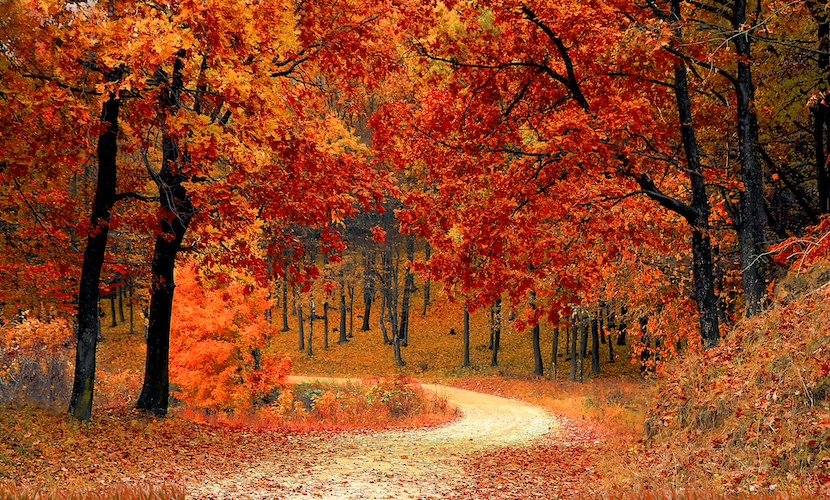
Over 200 years ago, the poet John Keats described autumn as the “season of mists and mellow fruitfulness” in his ode To Autumn. And indeed autumn really does have some spectacular colours and other wonders of nature just begging to be photographed. But how can you ensure that you make the best of this golden opportunity?
In this article we give you five top tips about how to get the best autumn shots.
First and foremost, you need to find the best places to get awesome shots. This can be a fun research project for you and the family, getting out and about just to check places out, before you actually go on an autumn photoshoot. Look for places that you like, that are convenient to get to, and – above all – have the potential for some spectacular shots.
Here are a few ideas to get you started:
Woods provide many opportunities for a wide range of shots, and often also include streams or small rivers. They should definitely form part of your photographic repertoire.
Beaches and coastlines can be stunning in autumn, whether on a wild or sunny day. And as well as the beauty of the scenery itself, there are also many other opportunities to photograph features such as pebbles, seaweed and driftwood.
You can get some amazing aerial and long distance shots from the tops of hills, and should also be able to incorporate a wide range of colours and textures in each image.
Buildings can make a wonderful backdrop for autumn photographs. Whether you want to focus in on a historic building in a city, a stately home in beautiful grounds, a remote castle or a woodland folly you have the beginnings of some stunning autumn photography.
To fully capture the gorgeous colours of autumn, aim to take your shots in either the golden hour (just after sunrise or before sunset) or the blue hour (just before sunrise or after sunset). Both the golden and blue hour will provide a lovely soft light which will give you a better opportunity for longer exposure times. And it’s also worth experimenting with different exposures even when it’s still dark, you may get some fabulous results.
So it’s always a good idea to check the times of sunrise and sunset and make sure you show up in the right place at the right time. Otherwise, if the sun is too high in the sky, you risk diminishing the autumn colours by the sunlight.
The opening quote from Keats referred to the mists of autumn, and misty autumnal mornings are a great time to get photos with an ethereal look. But even if there is no mist, there are things that you can do to enhance the ethereal look of your photos. Here are a few things to try:
Photos of water in which surrounding elements such as trees are reflected are always very atmospheric. Also try capturing the movement of water by using a slow shutter speed.
You can also use slow shutter speeds when photographing clouds, to imply movement and give depth to your shot. It’s always a good idea to look around and include as much sky and clouds as possible in your shots as this can really enhance the lighting effects of your image
We covered different kinds of camera filters in our recent article Filter This! An ND filter will slow down your shutter speed to reduce the light coming into your camera. It can help to capture stationary images sharply whilst blurring any moving objects. You can also get different graduations of ND filters which can darken part of the shot.
Just be sure that any movement you capture in your shot is intentional. With landscape photography it is particularly important to keep your camera still, ideally by using a tripod or other stabilising mechanism. What you don’t want is even the smallest element of hand shake, as this could spoil the perfect shot.
Contrast is one of the key elements of successful autumn photography. Contrast refers to the degree of difference between different elements in an image. It’s incredible the difference that higher or lower contrast will make to the feel of an image.
You can deliberately introduce contrast into your images by shooting your subjects against either lighter or darker backgrounds, making use of bright sky or dark shadows, or simply by using the power of different colours in your shot.
A polarising filter can help to boost contrast and colour in your shot whilst reducing reflection and glare. It can also enable you to work at a lower shutter speed to be able to capture motion whilst still maintaining contrast. Check out our recent article Filter This! for more useful information about different camera lens filters.
As with all types of photography, you can get some better autumnal shots by experimenting with different angles. For example, try shooting upwards to get some interesting shots of the tops of the trees from underneath. Or how about looking down to try capturing the colourful carpet of fallen leaves and foliage at your feet?
Autumn is also a good time to have a go at macro photography, i.e. close up shots of small subjects. For example plants, leaves, fungus, berries or even animals, birds or insects if you can get close enough. For more help with macro photography check out our article Small is Beautiful.
We hope that you feel inspired to get out and about this autumn and that the tips will show you to get the best autumn shots ever. Enjoy your autumn photography, and do check back here soon for more helpful photography guides from Print Your Memory.

Copyright 2025 © Print Your Memory. All rights Reserved.